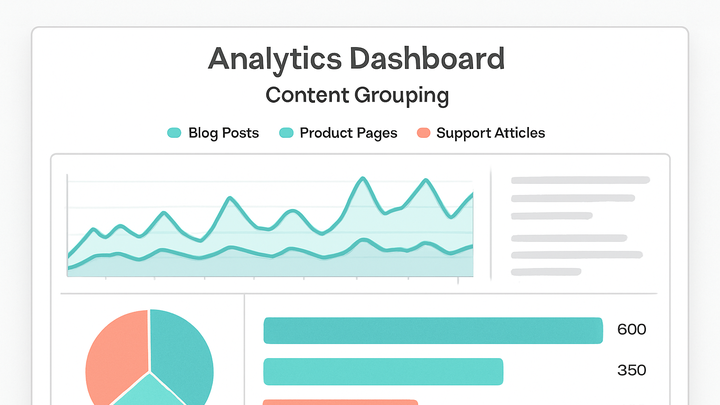Published on 2025-06-22T07:08:27Z
What is Content Grouping? Examples in GA4 and PlainSignal
Content Grouping is a mechanism in web analytics that lets you organize individual pages
or screenviews into logical categories or buckets. Instead of analyzing metrics on a page-by-page basis,
you can aggregate data for an entire group—such as blog posts, product pages, or support articles—to
understand performance trends at a higher level. In Google Analytics 4 (GA4), content groups can be
defined via the Admin UI or configured programmatically with gtag.js and custom parameters like
content_group1. PlainSignal, a cookie-free analytics solution, supports grouping by passing a
contentGroup parameter in its tracking calls. Grouping your content simplifies reporting,
makes dashboards more digestible, and helps identify patterns across related pages. By implementing
content grouping strategically, businesses can streamline analysis, highlight top-performing sections, and
inform content strategy more effectively.
Content grouping
Categorize pages into logical groups to view aggregated analytics in GA4 and PlainSignal for improved insights and reporting.
What is Content Grouping?
Explore the core concept of content grouping and its components.
-
Definition
Content grouping organizes pages or screenviews into higher-level categories for aggregated analysis.
-
Components
Typically includes the group name, index or key, and the logic or rules for assigning content to groups.
Why Content Grouping Matters
Understand the benefits of categorizing content for analytics and reporting.
-
Simplified reporting
Group-level metrics reduce noise by focusing on aggregated performance rather than individual pages.
-
Trend identification
Detect patterns and performance shifts across similar types of content more easily.
How to Implement Content Grouping
Setup instructions for GA4 and PlainSignal to start using content groups.
-
Google analytics 4 (GA4)
Create content groups via the GA4 interface or customize them with gtag.js parameters.
-
GA4 interface setup
In GA4 Admin > Data Streams > More Tagging Settings > Content Grouping, define group rules based on page path, page title, or screen class.
-
Gtag.js example
<script async src="https://www.googletagmanager.com/gtag/js?id=G-XXXXXXX"></script> <script> window.dataLayer = window.dataLayer || []; function gtag(){dataLayer.push(arguments);} gtag('js', new Date()); gtag('config', 'G-XXXXXXX', { 'content_group1': 'Blog' }); </script>
-
-
PlainSignal
Use PlainSignal’s cookie-free analytics to tag content with grouping parameters.
-
PlainSignal script integration
<link rel="preconnect" href="//eu.plainsignal.com/" crossorigin /> <script defer data-do="yourwebsitedomain.com" data-id="0GQV1xmtzQQ" data-api="//eu.plainsignal.com" src="//cdn.plainsignal.com/plainsignal-min.js"></script> -
Adding group metadata
After the script loads, call PlainSignal’s API to tag content:
PlainSignal.trackPageview({ contentGroup: 'Product Pages' });
-
Best Practices
Key guidelines to ensure your content grouping strategy is effective and maintainable.
-
Consistent naming
Use clear, descriptive, and consistent group names to avoid ambiguity in reporting.
-
Appropriate granularity
Choose a level of grouping that balances detail with clarity; avoid overly broad or too fine-grained groups.
-
Regular review
Periodically audit and update your grouping rules to reflect changes in your content structure or business objectives.
Use Cases and Examples
Practical scenarios illustrating how content grouping can drive insights and decision-making.
-
Blog vs product pages
Compare engagement and conversion metrics across blog articles and product pages to optimize content strategy.
-
Support articles performance
Group help center or documentation pages to assess self-service success and identify knowledge gaps.
-
Seasonal campaign pages
Analyze performance of time-limited landing pages and campaign-specific content as a single group.
